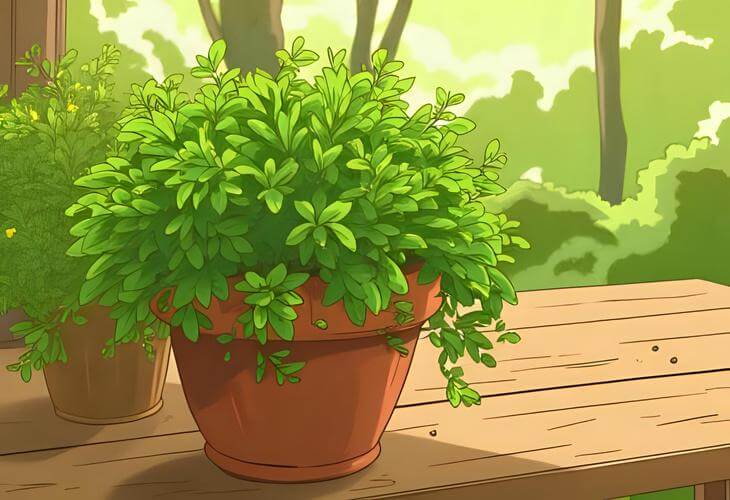
Thyme (Thymus spp.) is a low-growing, aromatic herb prized for its culinary uses, ornamental value, and exceptional drought tolerance. With its tiny leaves and clusters of delicate flowers, thyme brings flavor to the kitchen and structure to the garden, often acting as a fragrant groundcover or border plant.
Native to the Mediterranean, thyme is a resilient, sun-loving perennial that thrives in poor soil and requires little maintenance once established. Its dainty flowers bloom in shades of white, pink, or lavender, offering nectar-rich rewards to a host of pollinators. Whether tucked between stepping stones or cascading over container edges, thyme adds beauty, utility, and biodiversity to any garden.
Soil (pH) Requirements
Thyme prefers well-draining, sandy or rocky soil with a neutral to slightly alkaline pH, ideally between 6.5 and 8.0.
Soil Tips
- Avoid rich, moisture-retentive soils—thyme dislikes soggy roots.
- Incorporate coarse sand or gravel into heavy soil to improve drainage.
- Raised beds or container plantings work well where drainage is a concern.
Sun Requirements
Thyme flourishes in full sun, needing at least six hours of direct sunlight per day to maintain its compact habit and aromatic foliage.
Sunlight Suggestions
- Place in open, south-facing spots for maximum growth.
- In coastal or cool climates, it thrives in all-day sun.
- In very hot regions, a little afternoon shade can help prevent leaf scorch.
Watering Requirements
Thyme is drought-tolerant and prefers to be on the dry side once established.
Watering Guidelines
- Water young plants regularly until roots are established.
- Once mature, water only during extended dry periods.
- Avoid overhead watering to prevent fungal issues; water at the base.
Best Plant Hardiness Zones
Most thyme varieties are perennial in USDA Zones 5–9, though hardiness can vary by species and cultivar.
In colder regions (Zones 3–4), Winter protection or container growing may help.
In milder zones, thyme can stay evergreen year-round with occasional trimming.
Thyme’s Popularity and Pollinator Potential
Thyme is a garden multitasker—equally suited for herb beds, pollinator pathways, or patio containers. Its strong fragrance deters pests like aphids and cabbage moths, making it a great companion plant, and its carpet of blossoms provides abundant nectar in late Spring and early Summer.
Pollinators Drawn to Thyme
- Honeybees, which forage busily during bloom time
- Native solitary bees, especially small species like mason and leafcutter bees
- Hoverflies, which help control pests and feed on thyme nectar
- Butterflies, including blues and skippers that favor small tubular flowers
Like sunflowers—favored by bees, butterflies, and hoverflies—thyme plays a crucial supporting role in pollinator-friendly plantings, offering low-level nectar access and habitat cover.
Five Flavorful and Flowering Thyme Varieties
English Thyme
The classic culinary variety, English thyme is upright, shrubby, and highly aromatic. Its gray-green leaves and lavender blooms make it both attractive and practical. It grows to 12-18 inches.
Best Uses
- Culinary seasoning for soups, meats, and stews
- Herbal teas and infused oils
- Compact hedging in herb gardens
Pollinator Note: Its nectar-rich blooms are especially appealing to honeybees and hoverflies, offering vital forage in late Spring.
Zones: 5–9
Creeping Thyme
A vigorous groundcover, creeping thyme hugs the soil (just 2-4 inches high) and produces dense mats of pink or purple blooms. It’s perfect between stepping stones or spilling over low walls.
Best Uses
- Living mulch and erosion control
- Filling gaps in rock gardens or pathways
- Creating pollinator-friendly carpet plantings
Pollinator Note: With its spreading habit, it creates a floral buffet for tiny native bees, butterflies, and hoverflies.
Zones: 4–9
Lemon Thyme
This citrus-scented hybrid has bright green or variegated leaves and a distinctive lemony flavor. It’s ideal for both culinary and ornamental purposes. It grows to 8-12 inches.
Best Uses
- Flavoring chicken, fish, and vinaigrettes
- Adding zest to herbal teas
- Colorful edging or container filler
Pollinator Note: When in bloom, it draws butterflies, honeybees, and small beetles seeking sweet nectar and cover.
Zones: 5–9
Caraway Thyme
Named for its caraway-scented leaves, this low-growing variety (4-6 inches) forms a fragrant mat and is often used in culinary dishes with meats or root vegetables.
Best Uses
- Herb borders and alpine gardens
- Aromatic ground cover between pavers
- Cooking lamb and stews
Pollinator Note: Its blooms are especially attractive to hoverflies and mining bees, which forage close to the ground.
Zones: 5–9
Woolly Thyme
With fuzzy silver leaves and a spreading habit, woolly thyme is more ornamental than culinary. It’s often planted for texture, color contrast, and drought resilience, and grows only an inch or two high.
Best Uses
- Ground cover in dry, sunny beds
- Gravel gardens and roof plantings
- Low-maintenance filler around hardscape
Pollinator Note: Though it blooms less prolifically than others, its small flowers still provide nectar for solitary bees and hoverflies, particularly when planted en masse.
Zones: 5–9


 Previous
Previous

